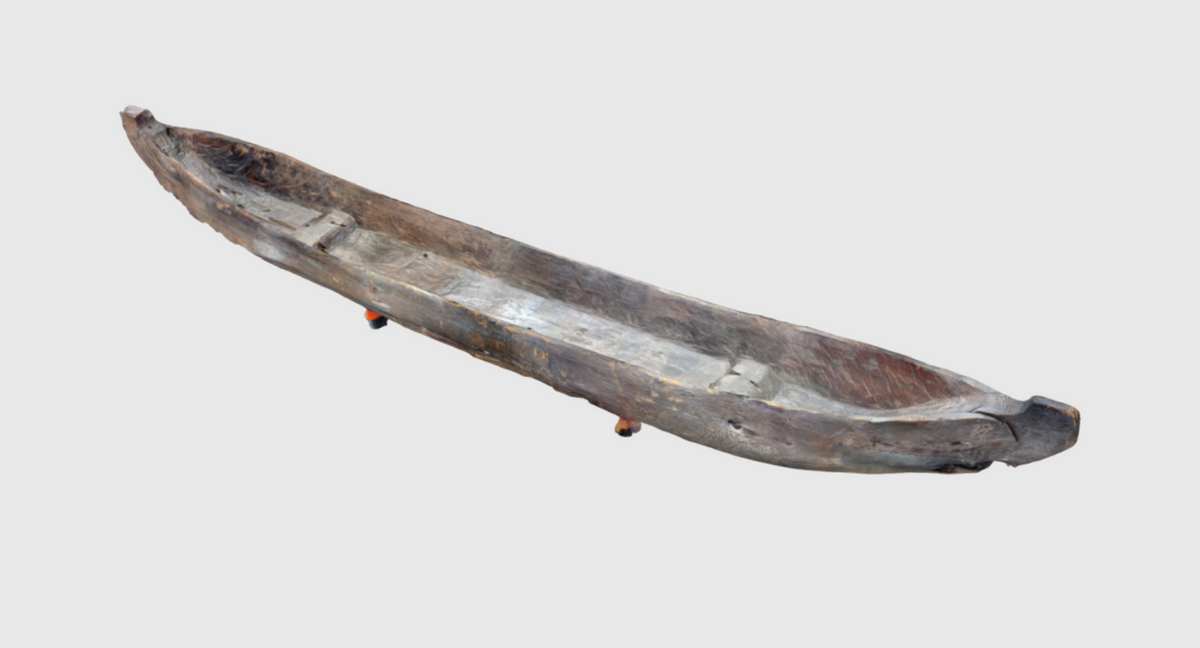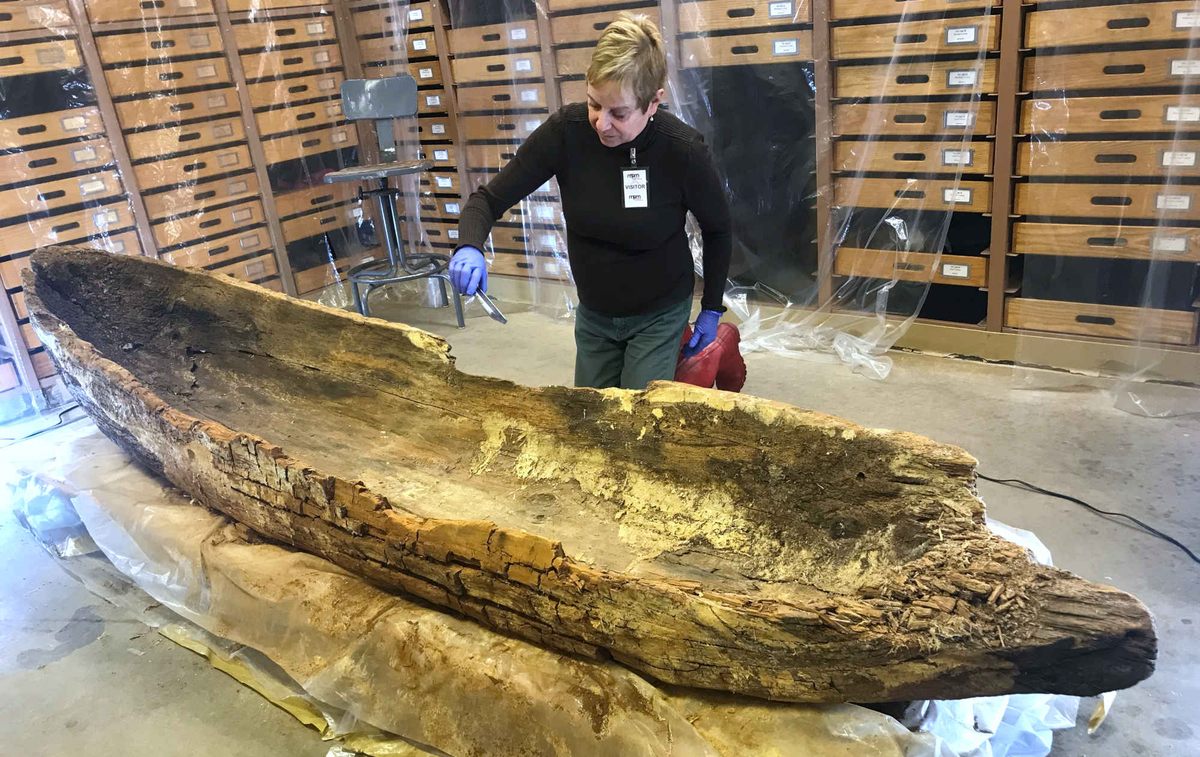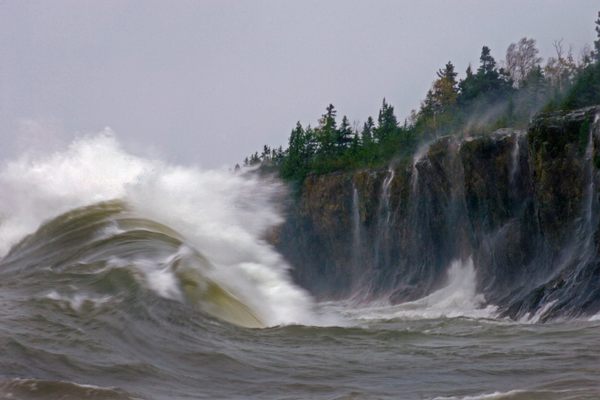Dugout Canoes, the ‘Pickup Trucks’ of Their Day, Go Digital in Wisconsin
For millennia, people used dugouts for transport and trade. Now, an ambitious project is preserving the canoes virtually and revealing new details.
This piece was originally published in Undark and appears here as part of our Climate Desk collaboration.
In July, at a boatyard warehouse on Chicago’s South Side, Tamara Thomsen inspected a roughly 15-foot-long canoe likely made more than a century ago. The canoe—called a dugout, because it was carved from a single tree trunk—rested on two construction horses, a bright light illuminating its contours and scrape marks.
Thomsen, a maritime archaeologist with the Wisconsin State Historic Preservation Office, used a GoPro to take photographs of the dugout, while Sissel Schroeder, an archaeology professor at the University of Wisconsin-Madison, swept her iPhone over it, capturing images for a 3D model. While the scans uploaded on Schroeder’s computer, she used tweezers to pry loose woody flakes to send to a lab, which might reveal the source of the dugout’s wood.
“This is beautiful,” said Thomsen as she inspected the interior.
The dugout canoe, which was likely made from a tree that once grew in Wisconsin, is one of more than five dozen located, catalogued, and photographed by Schroeder and Thomsen as part of the Wisconsin Dugout Canoe Survey Project, an effort to identify and document the origin, style, and tree species used to make dugouts. The team is also building a library of 3D interactive digital models of the dugouts, which is available to the public online. The Wisconsin canoes the researchers have found so far range in age from roughly 150 to about 4,000 years old, vessels that floated on Midwestern waterways, relics of another era and ecosystem.
Indigenous people of the time may have managed the forests to get trees that had characteristics they wanted and grew to the size needed for the dugouts. Identifying the species used at different points in time could indicate possible environmental shifts and provide more evidence of the forests’ makeup and how people used them.

“You don’t hear too much about the Native culture here before the first Europeans arrived. These dugout canoes, they take you back beyond that history. There’s a lot to learn from it,” said Bill Quackenbush, the tribal historic preservation officer with the Ho-Chunk Nation. “There’s a lot of healing that takes place from this. Every time we talk about our history and add another layer, such as the dugout canoes bring, it allows us to have another tool there to assure that we are still trying to retain our culture.”
For the last five years Schroeder and Thomsen have been contacting tribal nations and institutions—from the Smithsonian Institution to local museums—and asking after known and suspected dugouts documented in newspapers, recorded at the Wisconsin Historical Society, or just mentioned in discussion.
At first, researchers thought that just a handful of these boats originating from Wisconsin remained. A deeper investigation revealed more in collections and even a number still resting on muddy lake bottoms, where tribes sometimes stored them for the winter so they wouldn’t dry out and crack. What started as 11 documented canoes has grown to 80. Wisconsin now boasts the second largest number of reported dugouts in the eastern part of the country, after Florida.
“These objects have survived for thousands of years,” said Schroeder, which, she added, helps the public appreciate how long Indigenous peoples have existed in this area. Not only that, but the virtual library she and Thomsen are amassing from their work on these canoes could help others understand more about how the vessels were made, the environment at the time, and how people navigated the region’s lakes, rivers, and streams.
She added: “There are some interesting aspects of traditional technology that are being revealed by this study that I think nobody anticipated.”
Indigenous people used dugouts for millennia to travel, fish, and carry cargo. “Just look at a surface water map on the state of Wisconsin,” said Ray Reser, archaeologist emeritus at the University of Wisconsin-Stevens Point and anthropology curator for the university’s museum. “That was the highway system. That’s how things were typically moved.” As one Menominee elder once explained to him, he recalled in a recent interview, “dugout canoes were the pickup trucks and birch bark canoes were more like the fast little car. They were used for different things; dugouts were really meant to be utilitarian.”
People would allow trees to grow tall so that they could use the entire trunk, felling the trees when they were big enough to provide a wide and long enough dugout. Once down, builders would often burn, and then extinguish, small fires on the log, carving out the ash with stone tools.
For the Wisconsin Dugout Canoe Survey Project, the samples Schroeder and Thomsen take from the canoes could reveal where and from what trees the dugouts came from, offering hints as to how far the canoes traveled and what trees were available. Differences in size, shape, and wear patterns could indicate how people used the canoes, such as whether they helped people transport goods or collect rice, a practice typical of some northern tribes.
Schroeder and Thomsen send wood samples to labs for various tests. Some are radiocarbon dated, a method used to determine the age of the tree. Others go to the USDA’s Forest Products Laboratory in Madison, where a specialist uses longitudinal and cross section cuts of the wood to make slides, mount them, and match them to the cellular structure of other wood types.

Another lab will test samples for chemical signatures called strontium isotopes, which may indicate where a tree originally grew. Part of southwestern Wisconsin, for example, is known as the Driftless Area, a section characterized by topography and soil chemistry absent of the till typically left by receding glaciers, which is apparent in different strontium concentrations in the soil. Trees take strontium up in their tissue, resulting in ratios in the wood that may help Schroeder and Thomsen figure out where people likely cut a tree they then carved into canoe.
“By doing the strontium isotope analysis, we might be able to confirm that it came from the northern part of the state,” Schroeder told Undark. “That would help us either add something to its provenance or give clues on where to look for the provenance of that object.”
All of that information could paint a fuller picture of the past. Changes in that data over time could indicate how people moved or how the environment changed, which could have affected the trees available or preferred for dugouts.
A dugout’s history is often lost to time, especially if it is in a private or museum collection away from the environment it was created in, said Thomsen. “What we’re looking for is any clues that we can get.”
Scientists and archaeologists once thought that most of the boats would be made from white pine, for example, a buoyant tree found in forests in the northern part of the state for millennia. But Schroeder’s and Thomsen’s identifications so far show that while about two-thirds of the dugouts found are indeed made of white pine, the rest come from a wide variety of hardwood species, like elm, hickory, and white oak.
That may be due to the environmental conditions of the time. Pollen records from Wisconsin lakebeds suggest the climate was warmer and drier around 3,000 to 6,000 years ago, when many of the dugouts from the southern part of the state were made from elm, according to Schroeder’s and Thomsen’s findings so far. Under those conditions, said Schroeder, fewer oaks grew in a closed canopy forest and more oak savannas existed, where the trees branched closer to the ground. Elms, on the other hand, grow tall and straight into a vase-like shape, ideal for a dugout.
Evidence may show that dugouts built later may come from oak, which could show another change in the landscape: Indigenous people may have conducted fewer burns as their population shrank, after Europeans introduced diseases. Those who remained may have switched to relying on oaks grown in a closed canopy where the trees branched higher, telling a story of a changing landscape and the people who inhabited it.
More recent dugouts likely made by the Menominee in the mid-1800s were also constructed from tree species like hemlock and hickory, which could have replaced pines that were largely logged out of the area by then, an indication of what was available based on how Europeans harvested the area’s natural resources.
According to Schroeder, Indigenous people’s ecological knowledge “makes it possible to continue to build traditional material culture, even when the most abundant types of trees that had been there for millennia are no longer present.”
Schroeder and Thomsen can’t piece together information about the dugouts they find—and uncover more of them–without the help of tribal preservation officers. They regularly contact David Grignon, the tribal historic preservation officer for the Menominee Indian Tribe of Wisconsin, when they find what they think is a canoe made by the tribe. Grignon told Undark that the models the pair make are really good. “They did a lot of work on them,” he said.
Dugouts, he said, were important. “There was a need for them for certain periods of time,” Grignon added, and “the resource is readily available here.”

Earlier this year, as Schroeder and Thomsen looked at canoes on the Menominee Reservation, Grignon told them about a dugout at the Smithsonian Institute. With the help of a grant, they traveled to one of the museum’s storage facilities in Suitland, Maryland, in January to see the boat for themselves. When museum collections managers brought it down from the shelving unit and removed the muslin cover, Schroeder and Thomsen saw a dugout sent to the institution in the 1890s, which once hung with dozens of other vessels in the museum’s boat hall.
Back in Wisconsin, they also regularly coordinate with Quackenbush of the Ho-Chunk Nation. On Lake Mendota in Madison, Quackenbush is using ground penetrating radar to investigate the whereabouts of more dugouts. He currently uses the technology to identify unmarked graves at ancient burial grounds, and hopes to take the same approach to see how many canoes lay on the lakebed, where a 3,000-year-old canoe was brought to the surface last year, the oldest ever to be found around the Great Lakes at the time. He also uses lidar—a method of creating three-dimensional measurements of the Earth’s surface using pulses of light from lasers—and underwater photography to search for dugouts below the water.
Last year, he and others from the Ho-Chunk Nation finished making a dugout canoe from a cottonwood tree. They took the canoe on its maiden voyage around lakes and rivers in the area over a week, introducing tribal youth and others to the cultural tradition and experience as they paddled along.
“We’re going to continue to expand our knowledge with dugout canoes, we’re going to continue to use it to teach our youth and children some of our cultural components that we used to be able to enjoy as a people in this area,” said Quackenbush.
Students at the high school on the Menominee Reservation in northeast Wisconsin also plan to make a dugout this year. Building one, Grignon told Undark, is “a lost art that needs to be revitalized and brought back.”
As tribes work on restoring the cultural tradition of making dugouts, finding others in lakes may help tribal historic preservation officers and anthropologists accomplish another ambitious goal: identifying larger areas that deserve protection where the dugouts can be left where they were found, instead of pulling out single dugouts, which can dry out quickly and disintegrate if they are brought up from a lake bottom after centuries of being underwater.
In Lake Mendota, for example, more than one dugout canoe exists on the lakebed, prompting archaeologists to reconsider how to deal with the boats, perhaps by leaving them in their watery resting places. Lawmakers could create an archeological district, said Reser. Lake managers could then ask boaters to not to disturb the lake bottom by dragging their anchors, for instance, much like similar state and federal laws protect big shipwrecks in the Great Lakes.
In August, Schoeder and Thomsen traveled to Windigo Lake, tracking down a possible dugout flagged by the Wisconsin Historical Society. From a motorboat, they scanned the water with sonar, a device akin to a fish finder mounted on the boat’s transom, to look for anomalies roughly 15 feet long. Seeing one, they dropped marker buoys. Thomsen donned her scuba gear and went in. There, sitting on the bottom, was a dugout.
Though the pair couldn’t catalog the canoe the same way they could with those on land, Thomsen took pictures and marked its precise location. She also took a small sample that will fill in details about yet another dugout, part of the growing digital collection.




























Follow us on Twitter to get the latest on the world's hidden wonders.
Like us on Facebook to get the latest on the world's hidden wonders.
Follow us on Twitter Like us on Facebook